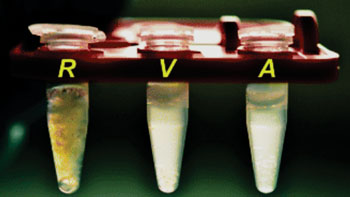Point-of-Care Processor Diagnoses Asthma and Tuberculosis
By LabMedica International staff writers
Posted on 19 Aug 2015
Effective processing and analysis of sputum samples are critical to the development of diagnostic platforms and personalized treatment approaches for pulmonary diseases, ranging from asthma to tuberculosis (TB).Posted on 19 Aug 2015
A device has been developed that mixes liquids using ultrasonics which is the first and most difficult component in a miniaturized system for low-cost analysis of sputum from patients with pulmonary diseases.

Image: The visual comparison of human sputum samples: (R) an un-liquefied raw sputum sample; (V) a sputum sample liquefied using a vortex mixer; (A) a sputum sample liquefied using the acoustofluidic device (Photo courtesy of Prof. Tony Jun Huang, PhD).
Scientists at the Pennsylvania State University (University Park, PA, USA) and their colleagues developed an acoustofluidic liquefaction device composed of serpentine microchannels with sharp-edges, called the “liquefaction region.” By doing so, they were able to repeatedly uniformly mix sputum sample and the sputolysin for as long as 30 seconds. Human specimens can be contagious, and sputum analysis requires handling of specimens in several discrete machines. With a lab-on-a-chip device, all biospecimens are safely contained in a single disposable component. Another issue is the sputum sample size required for analysis, which is often larger than a person can easily produce.
The acoustofluidic sputum liquefier requires 100 times less sample while still providing accuracy equivalent to the standard system. The activation of the piezoelectric transducer was controlled by amplified square-wave signals from a function generator. Samples from an asthmatic patient were tested and cell viability was assessed to evaluate the biocompatibility of the liquefaction device for processing clinical human samples. A thin layer of sputum cells was prepared by centrifugation using a Cytospin 3 cytocentrifuge (Thermo Scientific; Waltham, MA, USA) and stained with modified Wright–Giemsa stain. With the lab-on-a-chip system, a health professional can operate the device with a touch of a few buttons and get a read-out, or the patient could even operate the device at home. In addition, the disposable portion of the device should cost less than an USD to manufacture.
The authors concluded that the sputum samples liquefied using their acoustofluidic device were comparable to samples that were liquefied using a vortex mixer based on analyses of cell viability, modified Wright–Giemsa staining and flow cytometry. Tony Jun Huang, PhD, a professor of engineering science and mechanics and inventor of the device said, “To develop more accurate diagnosis and treatment approaches for patients with pulmonary diseases, we have to analyze sample cells directly from the lungs rather than by drawing blood.” The study was published on July 14, 2015, in the journal Lab on a Chip.
Related Links:
Pennsylvania State University
Thermo Scientific













